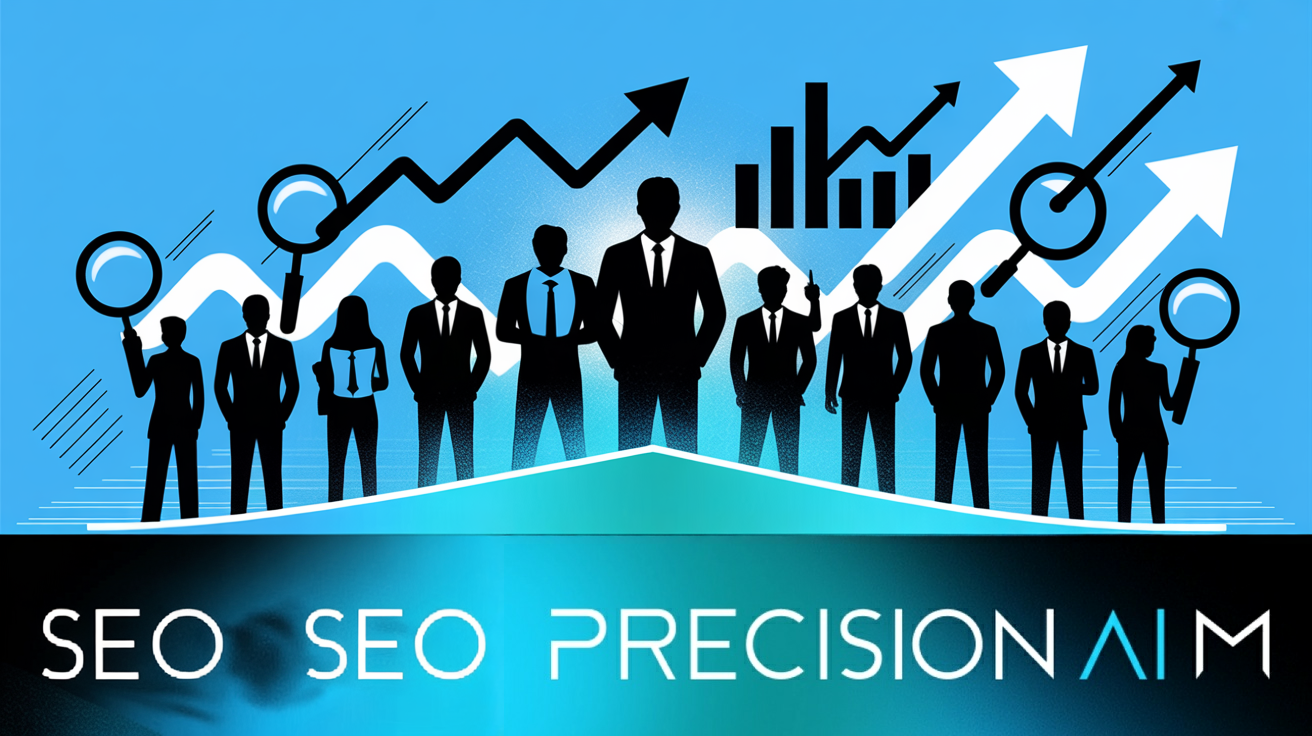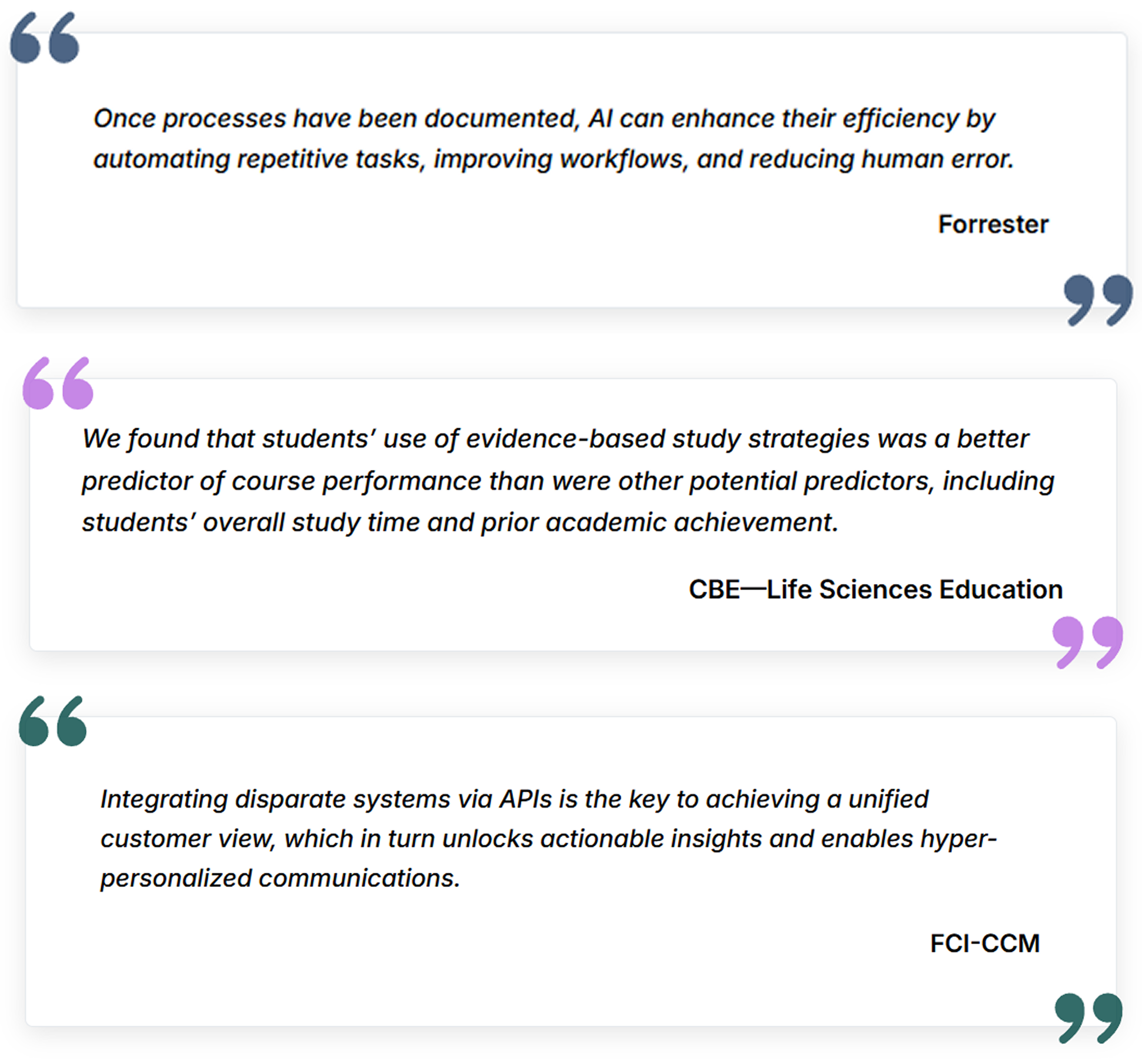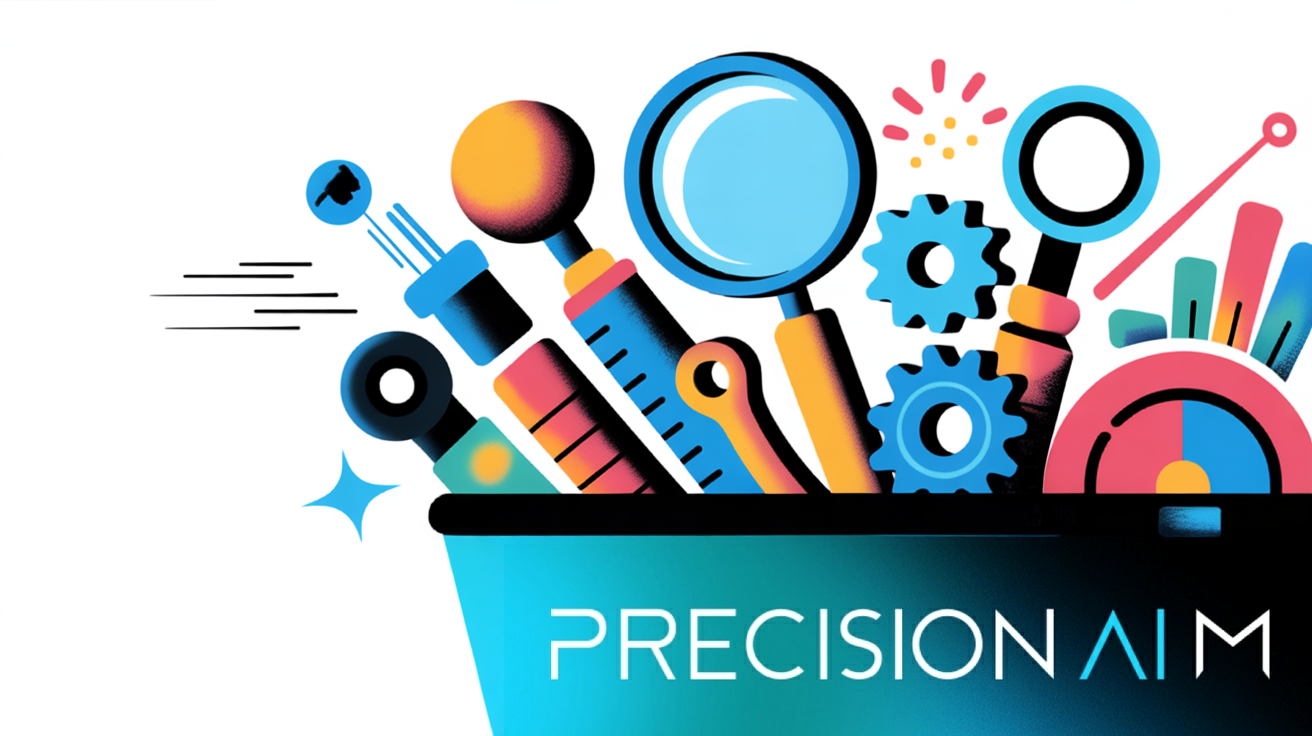Trying to improve your search rankings with outdated keyword tactics can feel like running in circles. Semantic SEO changes the game by focusing on context, entities, and topical authority—making your site more relevant to both users and search engines.
I've seen firsthand how working with the right semantic SEO consultant can unlock lasting organic growth, richer SERP features, and resilience against algorithm updates. But finding a true expert isn't always easy; you need proof of results, technical mastery, and clear communication.
In this article, I'll break down what sets top semantic SEO consultants apart, including their approach to entity optimisation, topic clustering, and schema markup. You'll get a detailed look at ten leading specialists, their unique strengths, and real-world client outcomes—plus practical tips for evaluating and integrating a consultant into your team.
By the end, you'll know exactly what to look for and how to choose a consultant who can future-proof your rankings and drive measurable results.
What defines the best semantic SEO consultants?
Understanding semantic SEO and its relevance
The landscape of SEO has changed dramatically over time. We’re well past the era when keyword stuffing was enough to boost rankings. Now, the real game is about context—figuring out the meaning behind what users are searching for. Semantic SEO takes things further; it employs artificial intelligence and natural language processing to unravel topics and relationships between concepts.
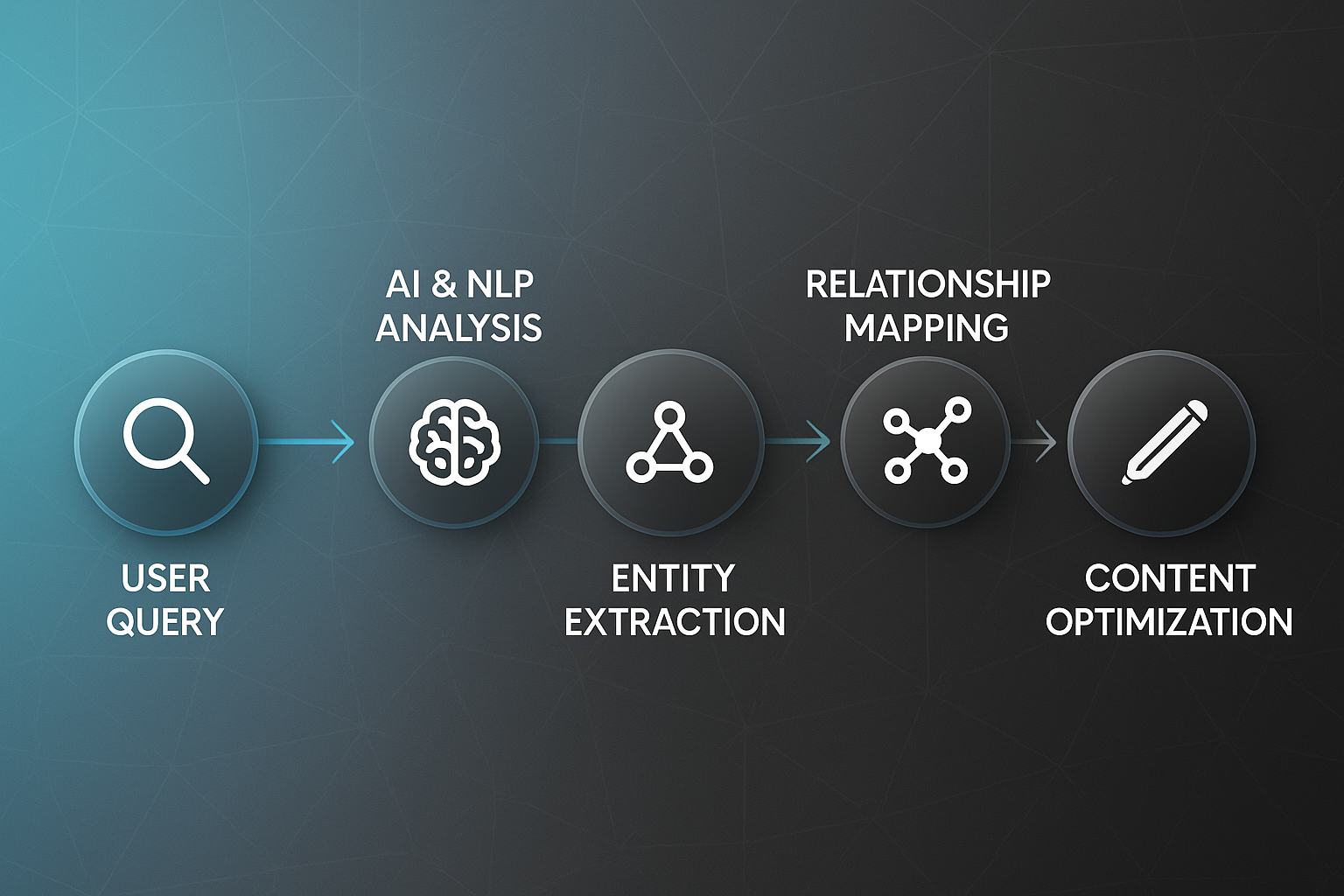
In traditional SEO, you're chasing a handful of keywords and hoping those specific phrases bring visitors. Semantic SEO, on the other hand, connects “entities”—these could be big topics, brands, or even people—and builds coverage across all the related subjects. That way, your site is ready to address questions users might not have asked explicitly.
Just look at how search algorithms have evolved, especially with updates like Google’s BERT. They now parse content with subtlety and depth, favouring sites that provide well-organised, relevant answers across a whole spectrum of subtopics. Sites with strong topical coverage see more visibility and users tend to stay longer.
BERT models can therefore consider the full context of a word by looking at the words that come before and after it—particularly useful for understanding the intent behind search queries.
How semantic SEO differs from traditional SEO
Here’s a good distinction: traditional SEO creates separate pages for each target keyword and tracks those rankings. Semantic SEO takes a more holistic approach, joining related articles into clusters and monitoring how comprehensive and relevant your content is. You also pay attention to special results, such as featured snippets.

Why entities, topical authority, and structured content matter
So, why do entities matter so much? Entities are defined concepts—brands, subjects, or products—that make your content clearer for both users and search engines. By optimising around entities and connecting them, your site comes across as more useful and relevant.
Topical authority signals expertise by offering in-depth coverage of a subject. If you layer in structured content with schema markup, you help Google interpret your information more accurately, which often leads to attractive listings such as reviews and product ratings.
The main benefit of structured data is that it makes your site eligible for rich results and other search features. Rich results can help your site stand out in Search results, and may encourage users to interact more with your site.
Impact of semantic strategies on rankings and organic growth
Embracing semantic SEO opens your site up to a wider range of queries—not just a short list of keywords. This increases your odds of appearing in rich features like snippets and panels. It’s also a future-proof strategy for voice search and algorithm changes, driving lasting growth.
Core principles and benefits of working with top consultants
What makes industry-leading semantic SEO consultants stand out? They’re masters of technical detail and apply systematic, entity-focused strategies tailored to the real meaning of your content.
When Google recognizes your brand as a trusted entity for a particular topic, it will reward your content with higher visibility, not just for a single keyword, but for a wide range of related queries.
Entity optimisation and contextual relevance
Expert consultants pinpoint essential entities, optimise pages, and use schema to clarify context—making your authority obvious to search engines and readers.
Topical authority building and internal linking networks
Content gets arranged in topic clusters, with pillar and supporting pages, boosting topical depth and reinforcing your site’s credibility.
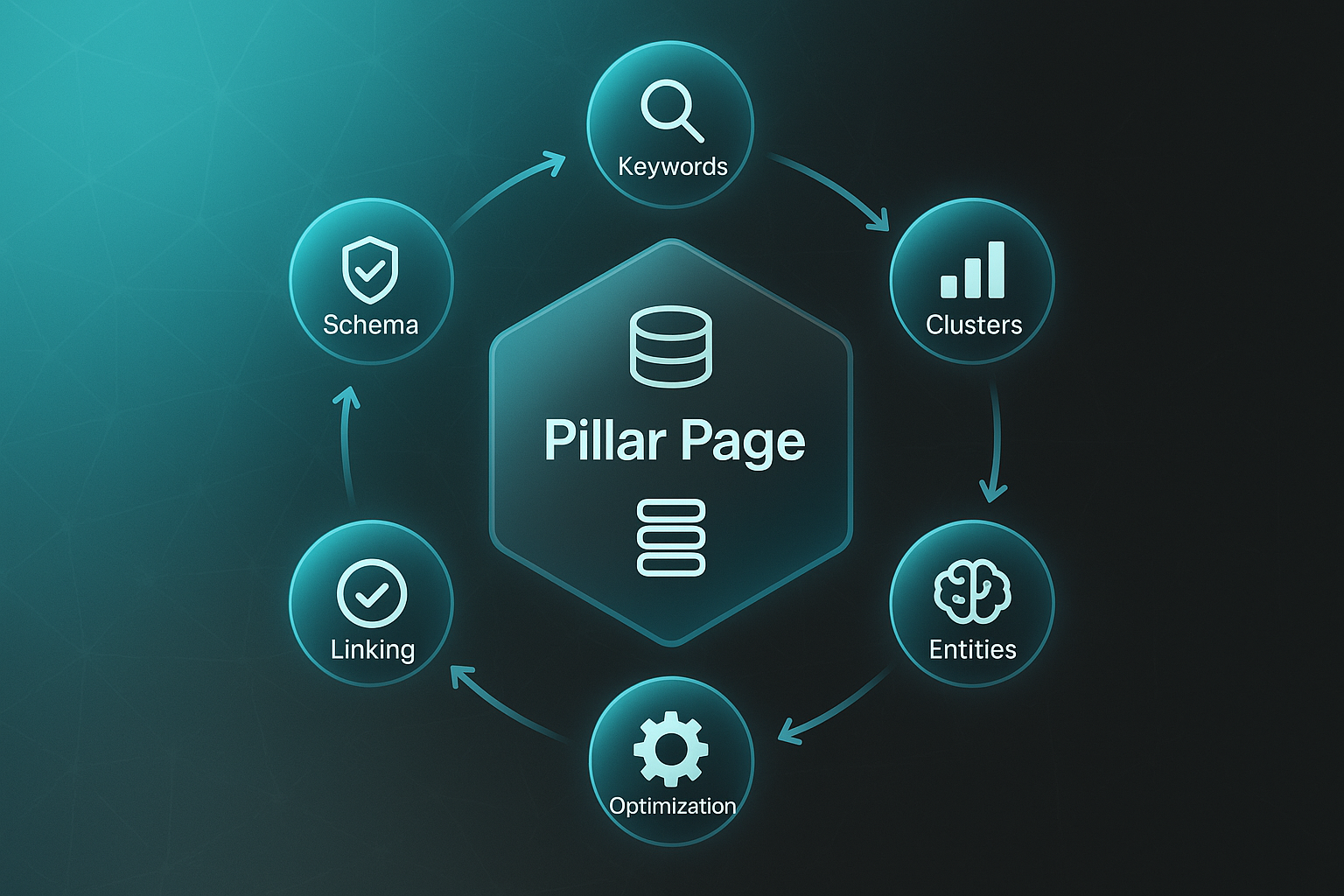
Structured data (schema markup) and rich results
Schema markup is utilised wherever possible, paving the way for your pages to win rich search results such as snippets and review stars.
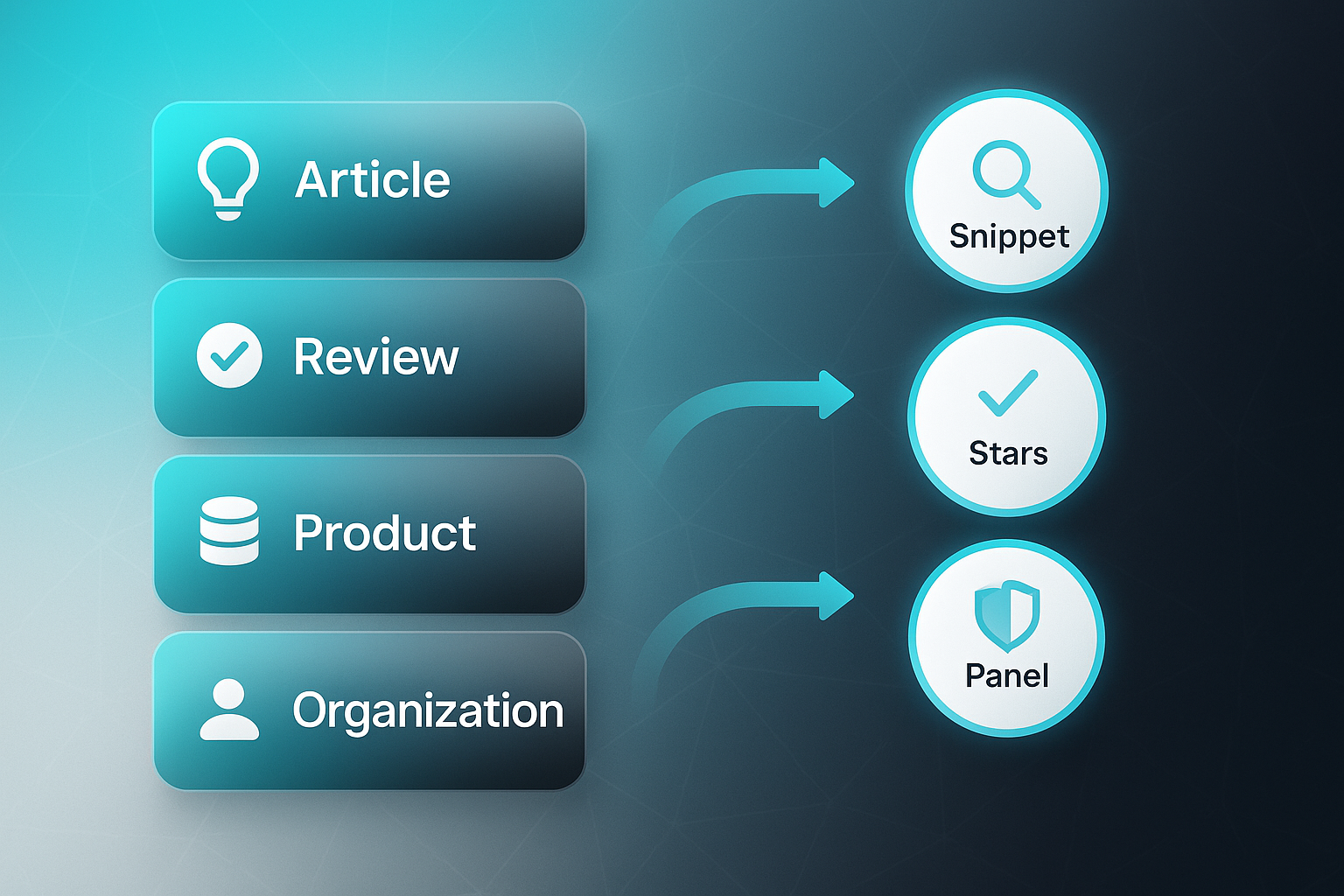
Future-proofing site visibility against algorithm updates
By prioritising entities and topics, consultants reduce your risk from algorithm changes. Ongoing tuning and E-E-A-T strategies keep your rankings and reputation strong.
Technical terminology primer
Let’s clarify a few core semantic SEO terms:
Entity
A distinctive person, place, or concept—like “Jaguar” as an animal or car brand—recognised by search engines.
Schema markup
Code that helps Google interpret page details, enabling features like reviews and rich product listings.
Topic cluster
A pillar page connected to related subpages, creating a comprehensive resource—e.g., a healthy recipes hub linking to diets and ingredients.
E-E-A-T
A quality metric: Experience, Expertise, Authoritativeness, Trustworthiness. For example, financial advice by a certified adviser enhances E-E-A-T.
Topical authority
Respect earned by fully exploring a subject, such as a tech site publishing a series of deep-dive articles and analyses.
How to evaluate and select a semantic SEO consultant
Proven experience and expertise
Choosing a genuine semantic SEO consultant means looking past impressive promises. You need to see verifiable results and clarity in their track record.
Placing testimonials on a sales page can increase conversions by 34% because they provide the social proof needed to build trust and overcome buyer skepticism.
Ask for published case studies and client testimonials that show measurable wins. These should include boosts in organic traffic, new keyword rankings, or featured snippet placements.
Can they provide “before and after” analytics? Having dashboard links or clear data to inspect is invaluable. If someone can show proof in real numbers, that’s a major advantage.
Don’t just settle for their word. Request a documented walkthrough of a previously completed project. This should reveal the step-by-step process and highlight use of specialist tools like MarketMuse, Semrush, or entity modelling software.
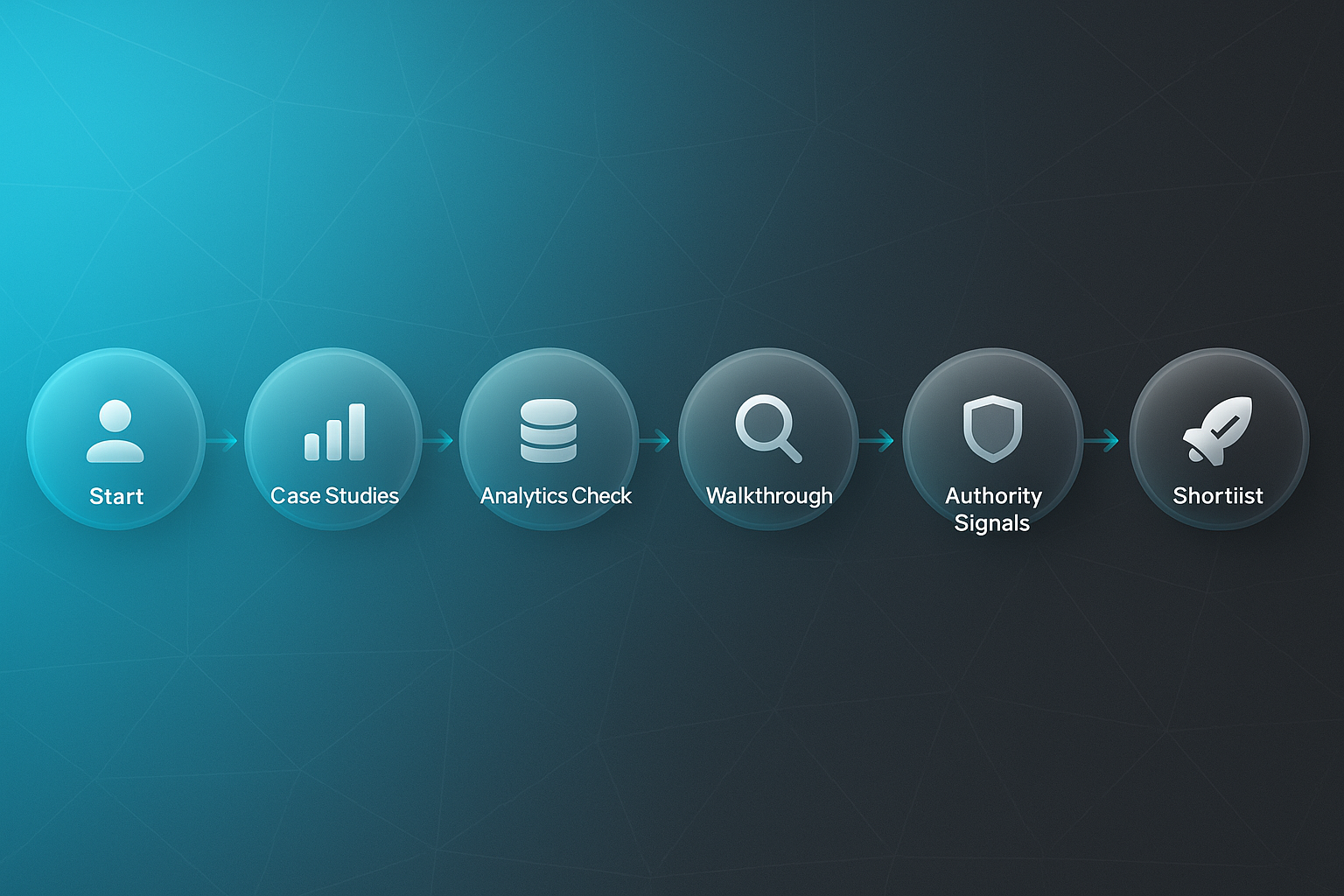
Check for visible authority signals too—industry speaking engagements, technical blogs, or research publications. Those who teach and share knowledge tend to have real expertise behind them.
Technical and strategic capabilities
Technical mastery is vital, but strategy is equally important. Ask for schema implementation proof—a screenshot or link from a validator like the Google Rich Results Test works well.
Are their schema examples tailored to relevant types for your sector, such as Article, Product, or Organisation? That’s what you’re looking for.
See if they can share maps or diagrams from real topic clusters or internal linking networks. Diagrams of pillar and supporting pages are tell-tale signs of solid structural thinking. A true specialist organises content strategically, not just for keywords.
Push for quantifiable results: more ranking keywords, greater entity exposure, or better engagement metrics. Have they explained their E-E-A-T strategy or how they map key industry entities?
Communication, reporting, and workflow integration
Great technical skills only shine if communicated clearly. Review sample reports and dashboards for KPIs—look for coverage of entities, cluster growth, and performance trends.
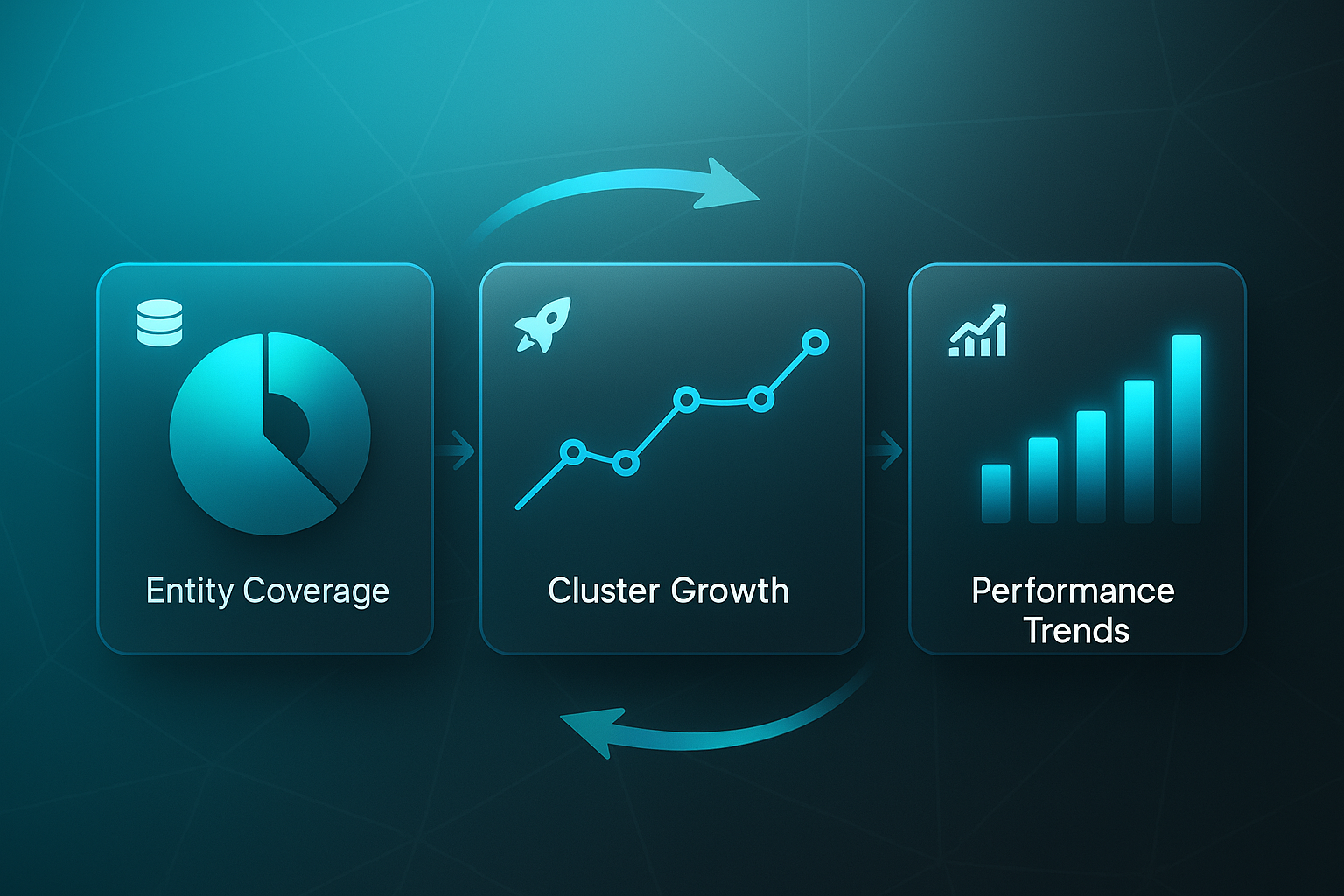
Are these reports both visual and straightforward? They should suit executives as well as technical staff.
The primary objective of a user-centric dashboard is to streamline the understanding of complex metrics and make critical data more accessible and actionable, enhancing the ability of managers to provide effective guidance.
Ask about training resources for non-specialists. Leading consultants provide onboarding materials or sessions to explain semantic SEO concepts.
Transparency really matters here. Request milestone-based proposals that detail who is doing what, when, and at what cost.
Will their processes slot neatly into your tech stack—WordPress, Shopify, or another platform? Ask for case studies showing adaptation. Discuss pricing and project timelines upfront, so nothing is hidden.
Selection frameworks and checklists
So, how do you narrow down your choices? Start with smart, evidence-based questions:
- Can you show a validated topic cluster in a competitive area?
- Which tools do you use for schema and entity analysis?
- How do you catch post-launch schema errors or gaps?
Use a simple scoring table to help compare:
| Criteria | Evidence to Request | Score (1-5) |
|---|---|---|
| Schema implementation | Validator screenshots, schema test links | |
| Topic cluster mapping | Maps/diagrams from real projects | |
| Reporting transparency | Sample reports, dashboard views | |
| Platform compatibility | CMS-specific case studies |
Essential selection checklist
- Verifiable project results
- Mastery of schema, clusters, linking
- Executive- and tech-friendly reports
- Clear deliverables and pricing
- Platform compatibility experience
Ask smart questions, gather evidence, score each candidate, and compare proposals. This sequence lowers your risk and helps you choose a consultant who’ll deliver measurable, sustainable semantic SEO growth.
Semantic SEO versus traditional SEO: decision frameworks
Comparing attributes and outcomes
There’s a real divide between traditional and semantic SEO, and, at heart, it’s keywords versus context. Traditional SEO revolves around targeting single keywords, building pages to fit those exact phrases, and perfecting tags and headings for them.
Semantic SEO takes a wider view. Instead of chasing isolated keywords, it sets content around broader topics or entities, answering diverse related questions and mapping subtle relationships. It’s not just about “what do people search?”, but “what do they want to know next?”
Keyword focus versus entity/topic focus
Picture a retailer who goes all-in on “buy running shoes” repeatedly. That’s the keyword-first approach of traditional SEO. Now imagine a site sprawling with guides—for novices, marathon plans, injury advice—all interconnected. Semantic SEO orchestrates that sort of networked content, designed to reflect genuine user journeys.
Traditional SEO can achieve quick, niche wins, especially in small or local spaces. But it’s prone to missing broader opportunities. Semantic coverage, by contrast, draws in deeper trust and longer-term rankings.
Siloed pages versus content clusters
Classic techniques usually result in lots of thin, standalone pages. These are easy to overlook and tough to keep fresh. Semantic SEO thrives on content clusters: pillar pages for important topics that link to detailed subtopics. This structure boosts user engagement and strengthens topical authority.
Adaptability and resilience
Here’s the thing—semantic SEO aligns beautifully with what Google now values: intent, depth, and structured data. Keyword-only sites risk sudden drops when algorithms change. Semantic orchestration, though, is naturally resilient.
Quick-reference comparison table
| SEO Model | Strengths | Limitations | Best Fit |
|---|---|---|---|
| Traditional | Quick niche wins; simple structure | Vulnerable; limited reach | Small/local sites, transactional terms |
| Semantic | Builds authority; future-proofed | Resource and planning intensive | Content-led brands, complex topics |
| Hybrid | Balanced; covers all journeys | Needs alignment and oversight | Scaling or competitive sectors |
Leveraging AI-powered platforms: SEOSwarm and consultant synergy
SEOSwarm features supporting semantic SEO objectives
SEOSwarm fuses artificial intelligence with genuine SEO expertise to elevate entity-focused strategies. It starts with agent-led research—AI uncovers user intent, relevant topics, and entities in your industry. Human specialists then refine this plan, fitting it to your brand's priorities.
A real standout? SEOSwarm automates content cluster building and internal linking, connecting related pages smartly without endless manual tweaks. Schema markup is added by default, improving your eligibility for rich snippets and knowledge panels.
Every step bakes in EEAT checks—ensuring experience, expertise, authoritativeness, and trust reflect in each piece. Your standards never slip, no matter how large or fast you scale.
Optimising scale, affordability, and sustained performance
Ever longed to launch a semantic-ready blog in minutes? With SEOSwarm, brands can do just that—instantly deploying or upgrading sites across any CMS.
The platform’s AI delivers constant monitoring, so missing schema, weak internal links, or thin areas get flagged before they can harm your visibility. Updates are unlimited and maintenance is continuous.
You get real-time, executive-ready dashboards showing topical coverage, site health, and the signals that actually affect authority and ranking. Decision-makers and marketers alike turn insight into action, not noise.

Automated audits and smart tuning mean your content’s impact keeps compounding—without new hires or manual workload increases.
Blending consultant expertise with technology for best results
Here’s what’s clever: SEOSwarm is designed to suit consultant collaboration, not replace it. Consultants use SEOSwarm's audits and entity maps to craft content architectures or pinpoint industry-specific gaps.
The platform then implements, maintains, and optimises—so experts can focus on strategy, and teams don’t drown in tech detail. This hybrid approach is made for fast upgrades, big content pushes, and streamlined reporting.
Internal or external strategists use unified dashboards to monitor progress, ensuring everyone’s always in sync.
Summary table: Key SEOSwarm features and their benefits
| Feature | Benefit |
|---|---|
| Agent-led topic research | Maps target topics and user intent for campaigns |
| AI topic cluster automation | Scales internal linking and structure for authority |
| Schema & E-E-A-T checks | Increases SERP features and boosts trust automatically |
| Instant blog deployment | Launches fast, integrates with any CMS |
| Continuous performance audits | Flags gaps and ongoing optimisation |
| Hybrid consultant integration | Empowers consultants to deliver at scale |
| Executive-ready reporting | Tracks coverage, authority, and business impact live |

AI-Powered Content Strategy
See the AI platform that's replacing entire content teams (with better results).

Integrating a semantic SEO consultant into your team and workflow
Collaboration frameworks and communication best practices
Getting a semantic SEO consultant involved should start off clear and well-organised. Begin by sharing core documents—think business objectives, those all-important platform logins, and a list of everyone who matters to the project.
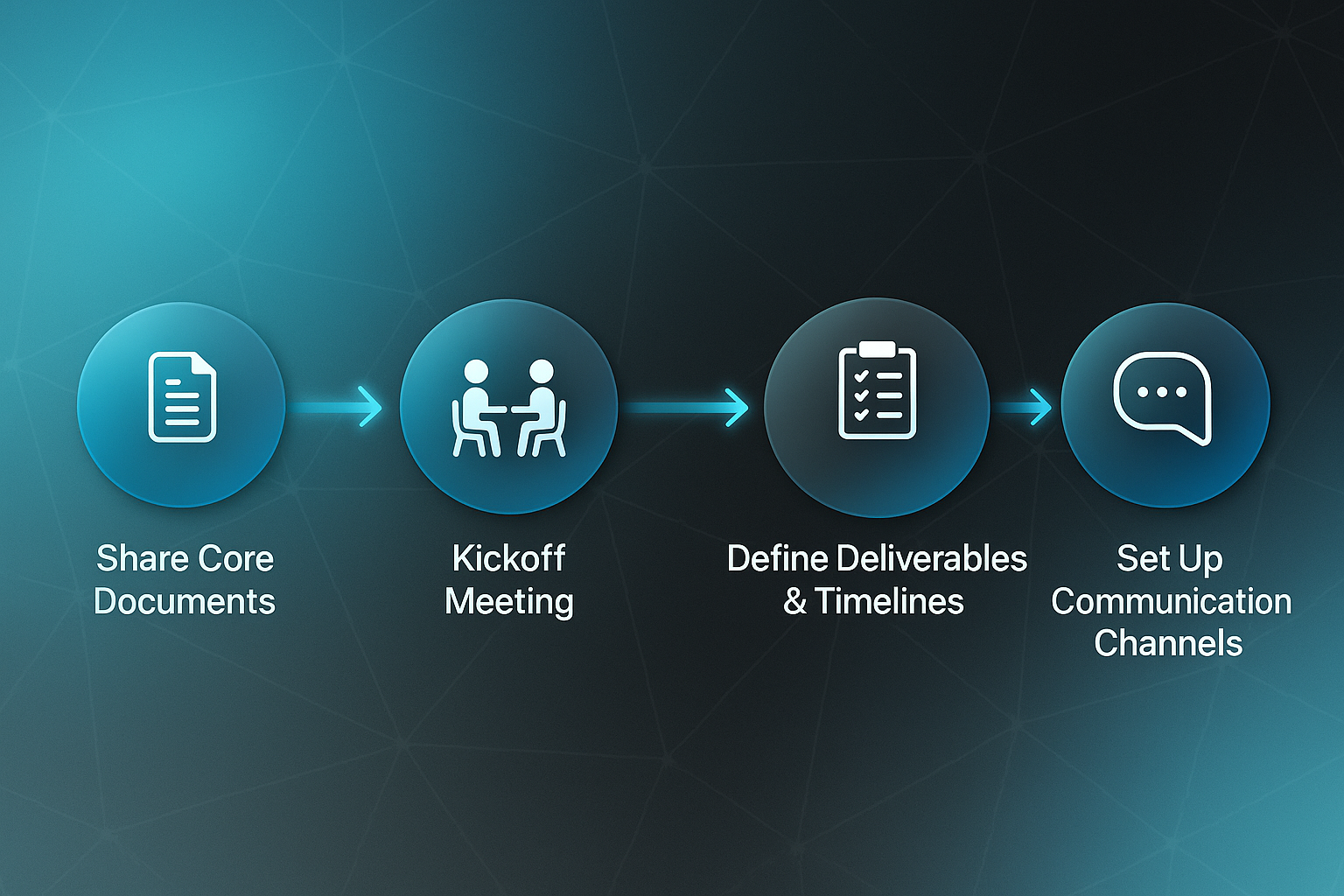
It’s genuinely worthwhile to host a kickoff meeting where you clarify deliverables, timelines, and how reporting will happen. Setting those parameters early avoids last-minute scrambles and mismatched expectations.
Designating a project manager—or one main contact—will keep communications tidy, with no missed messages or blurred roles. Project management tools like Asana or Trello work smoothly for task lists, while channels such as Slack or Teams keep quick queries and updates visible for everyone.
You want to pin down early on exactly who’s responsible for what. The consultant’s role is strategy, training sessions, and mapping out entities; the in-house team picks up content creation and technical support.
It’s important both sides agree shared targets—like improvements in topical authority or richer SERP features—and stick to a reporting schedule for tracking wins and tweaking tactics.
A quick onboarding checklist helps:
- Identify and introduce stakeholders
Make sure everyone knows the team and their roles instantly. - Define project objectives and metrics
Align on success criteria that matter to both sides. - Provide access to systems
Give consultants the right logins from day one. - Establish communication channels
Use Slack or Teams for collaborative, fast chats. - Schedule regular check-ins
Keep everyone on track and adapt as you go.
Koray Tuğberk GÜBÜR
Background and expertise
If you’ve heard the name Koray Tuğberk GÜBÜR, you already know he’s at the bleeding edge of the semantic SEO world. He’s not just tinkering on the sidelines—he’s the founder and leading mind behind Holistic SEO & Digital, where he wears both the CEO and chief architect hats.
So, what sets him apart? At heart, GÜBÜR’s a data scientist with years of hands-on SEO trenches behind him. But what really defines his approach is an almost forensic obsession with how Google actually works.
He dives deep into topics like topical authority, entity mapping, and the realities of Google’s ever-shifting patent landscape. His ideas consistently push the envelope—especially that part about integrating NLP and semantic relationships into the daily business of SEO long before the term “semantic” was an industry buzzword.
GÜBÜR’s trademark? He’s always more interested in why and how things rank, not just what happens to land a spot at the top.
Throughout his career, it’s this fusion of technical SEO wizardry—think crawl efficiency, meticulous use of semantic HTML, and rigorous structured data—with strategic content prowess that’s made his mark. GÜBÜR isn’t just working with the run-of-the-mill brands either.
He’s advised over 700 businesses worldwide, with an especially strong presence in those volatile, high-stakes sectors like finance, SaaS, sprawling e-commerce ecosystems, and the tricky world of international legal. His so-called “Koraynese” or Holistic SEO approach is now shorthand in the industry for comprehensive topical mapping and avoiding the tired old link-building focus—he’s much more about context and clarity.
And when he’s not directly advising clients? You’ll find him leading public workshops, masterminding advanced masterclasses, and tirelessly producing resources such as his sought-after Semantic SEO course.
These open-access guides and deep-dive research pieces have become required reading for technical and business audiences alike. They’re shifting the baseline for what counts as cutting-edge practice.
One area that really stands out: GÜBÜR has developed a reputation for picking through Google’s latest patents, reverse engineering what matters, and then teaching others the practical implications—often months or years before the broader market catches on. You’ll see him sharing insights on the BlueHat SEO Series and in technical interviews.
He’s always breaking down esoteric concepts for anyone hungry for a deeper understanding. His influence extends beyond the classic agency-client model.
GÜBÜR is often the brain trust for SaaS platforms and SEO tool-makers, showing them how search engines consume semantic and structured data at a much bigger scale. That cross-pollination—consulting, education, and product development—all stitched together, is what elevates him to genuine architect status for modern SEO thinking.
Methodology and approach
At the heart of GÜBÜR’s work is his 41-rule semantic optimisation framework. It’s a mouthful, but what that means is no detail goes ignored—from the tiniest query variant to the overarching entity structure of an entire industry.
It all begins with interactive topical mapping. Imagine drawing up a complex, living blueprint where every subject, sub-entity, and intent-driven query is visualised.
This isn’t just theory: he brings in NLP-driven tools that extract, model, and clarify how all the concepts and entities relate within a sector. What comes next?
For every single node on that map, GÜBÜR develops content briefs that don’t just hit the surface—he crafts them to address the myriad ways people might search or express curiosity, plus fills in those subtle gaps that your competition never notices. Everything’s context-aware, making sure both user and search intent are satisfied across the board.
Here’s what truly changes the game: he’s not in it for the keyword glory. GÜBÜR’s principle is “ranking topics, not keywords.”
Through smart clustering of related entities and an intricate internal linking structure, he force-multiplies topical authority. Authority flows across your site in a way that reflects the deeper logic Google is now using, thanks to principles borrowed from contextual PageRank.
And if you’re wondering, “But is this all just theory?”—here’s the kicker: the framework is engineered to minimise dependency on backlinks. Ranking credibility is earned primarily via content clarity, relentless schema integration, and an unflagging focus on machine-readability.
He’s a big believer in A/B testing, too—nothing gets left to chance when it comes to fine-tuning what works with real search engine behaviour. Nuts-and-bolts matters are always covered: word cloud analysis, entity extraction modules, DOM visualisation, and ruthless pursuit of crawl efficiency.
Whether it’s open workshops, proprietary technical audits, or tailored in-house training, you’ll find GÜBÜR’s process always steers clients towards internal capability-building. No mystery or black-box wizardry—his clients leave skilled enough to keep evolving on their own.
Koray Gubur's 41-Rule Semantic Optimisation Framework
- Topical map construction
Map out and visualise every major topic, entity, and possible query—nothing is left off the plan. - Entity-based content briefs
Every brief zeroes in on defining entities, surfacing variants, and setting clear linking for both users and bots. - Internal linking by topic relationship
Authority isn’t random; it flows along sensible topical lines, reinforcing genuine subject depth. - Schema integration at all levels
Schema is applied sitewide—no page left behind—making everything easier for machines to understand. - Ongoing A/B testing
Each tweak is measured, retested, and sharpened in the real world to stay a step ahead of ranking shifts. - Practical training for in-house teams
No dependency traps here—teams are trained to run, test, and iterate strategies long after the engagement.
GÜBÜR’s guiding mantra? “Rank topics, not keywords. Write as long as needed and as short as possible. Build trust by making content structured, semantic, and easily retrievable.”
You’ll see that thread tying together all his courses, case studies, and how-to documents—it’s about systematic depth, clarity, and true authority.
Notable case studies and client outcomes
When it comes to proof, GÜBÜR's client roster reads like the industry’s toughest verticals. Think high-volatility finance, YMYL, and international SaaS.
For example, take Vizem.net, a leader in the visa consultancy space. GÜBÜR took them through his exhaustive topical mapping process, resulting in entity-rich briefs that let them dominate both niche and core search demand.
And when Google’s algorithms started favouring semantic depth? Vizem.net was primed, outperforming rivals still hooked on backlink chasing.
This story is now a case study staple, showing how well-built entity coverage trumps legacy SEO every time. Jump to finance and YMYL.
At EB5Brics.com—an immigration finance platform—GÜBÜR’s model re-centred the whole site around relevant “predicate” actions and the corresponding entities (think “invest,” “migrate,” “apply”).
By stripping out content fragmentation and rebuilding around those critical links, the site held—and then grew—its authority. They picked up those elusive featured snippets through every Google core update.
Other, less publicised projects follow the same pattern. Several anonymous clients have reported 1000%+ traffic growth within four months.
Huge jumps in keyword footprints and resilience through stormy algorithm updates were observed. It’s not just a temporary boost—these gains tend to stick, backed by recurring audits and clear performance tracking.
One standout involved a SaaS enterprise that saw its organic sessions leap from under 30,000 to over 350,000 annually after switching to GÜBÜR’s topical cluster model. That translated into more non-brand queries, better targeted leads, and an organic, self-sustaining content engine that no amount of paid ad spend could beat.
Even e-commerce players have benefitted—advanced schema layering and systematic content rewrites led to a sharp rise in SERP features (like product and FAQ snippets). All this while reducing expensive reliance on paid campaigns.
Impact Metrics and Industry-Positioning Outcomes
- Keyword and entity footprint expansion
Your site’s universe of addressable queries grows—fast. - Featured snippet and knowledge panel acquisition
Structuring pages right puts you straight onto those rich SERP features. - Ranking resilience after Google updates
A strong topical map shields your rankings instead of exposing them to sudden drops. - Reduced dependency on backlinks
Authority flows through semantic clarity—not simply old-school link-building.
Each case is supported by testimonial evidence, public case breakdowns, and even step-by-step technical debriefs in his BlueHat SEO Series and course libraries. The numbers—sessions, CTR, knowledge panel picks—track right alongside long-term gains in highly competitive markets.
That transparency in measurement and reporting is something enterprise and compliance-heavy clients truly value.
Industry focus and differentiators
GÜBÜR is at home in SaaS, consumer and business finance, YMYL, e-commerce, and ultra-competitive B2B/B2C spaces. SaaS especially benefits from his ability to tie features and workflows into entity-driven query maps, spurring non-brand growth and clear market positioning.
In finance and YMYL sectors—where credibility and compliance are everything—GÜBÜR’s structured data approach, meticulous schema implementation, and deep focus on trust signals help brands sail through challenging regulatory and user trust waters.
While much of the industry is still caught up in incremental keyword expansion and churn-and-burn link campaigns, GÜBÜR’s defining strength is rigorous, research-backed process. He engineers for semantic breadth and depth, plans defences against major Google flux, and delivers documentation that teams can actually put into practice, not just one-off templates.
The resources he’s developed—a massive public case study archive, detailed SOPs, the BlueHat SEO Series, and technical scorecards—make even high-level concepts actionable for smaller players or those unable to engage direct consultation.
And there’s something else: GÜBÜR has taken “giving back” seriously. He reinvests in the SEO community through continual workshops, rewriting and updating his material as Google and the industry shift.
His conference presentations go beyond theory, focusing on the real mindset shift needed to move from keyword counting to a true entity-first, technically mature paradigm. Many in the next generation of technical SEOs have come from his curriculum, helping him push the industry forward at every level.
Recently, he’s also been a key influence on government and enterprise training efforts. Partnering with large marketing agencies, mentoring up-and-coming technical talent in emerging markets, and even helping build SEO curriculum for universities—his vision for “entity-first” thinking is making waves well beyond standard campaign delivery.
For brands and agencies wanting lasting capability and cultural change, that’s a true differentiator.
Expanded summary table: Koray Tuğberk GÜBÜR at a glance
| Area | Details |
|---|---|
| Technical Specialties & Focus | Semantic SEO, entity optimisation, topical authority, technical SEO (semantic HTML, Core Web Vitals, DOM structuring), AI/NLP frameworks, algorithm reverse engineering, cost of retrieval optimisation |
| Proprietary Methods & Tools | 41-rule Holistic SEO framework, entity and topical maps, Algorithmic Authorship, semantic automation, A/B testing, custom word cloud and DOM structuring analyses |
| Industries & Project Types | Visa/immigration (Vizem.net), finance/YMYL (EB5Brics.com), SaaS (product and use-case mapping), e-commerce (schema and cluster networks), hyper-competitive B2B/B2C brands |
| Measured Outcomes & Metrics | 1000%+ organic traffic increases, vast keyword/entity expansion, rich SERP results, stable ranking through Google updates, minimised backlink needs, durable, visible SERP presence |
| Educational Offerings & Public Resources | Semantic SEO authority course, BlueHat SEO Series, templated SOPs, technical articles, conference talks, hands-on enterprise workshops |
| Key Differentiators | Industry-shaping research rigour, empowering clients and teams, open evidence-based reporting, future-ready strategies, entity-first—never just keyword or backlink—philosophy |
Michael King (iPullRank)
Experience and unique strengths
Ever cross paths with someone who effortlessly blends technical and semantic SEO? That’s Michael King, founder of iPullRank. His Relevance Engineering model fuses technical SEO, AI, and NLP for smarter, context-rich content.
King’s secret sauce is combining machine learning, retrieval-augmented generation (RAG), and prompt engineering. These elements enable entity optimisation at a remarkable scale, simplifying complex websites for major brands and agencies.
Whether supporting direct clients or acting as an “agency for agencies,” King streamlines technical woes and brings clarity to vast site structures.
Notable results and methodology
But what does success actually look like here? King’s team deploys automated audits and builds programmatic workflows, driving measurable lifts in organic traffic and revenue.
Their AI-powered automation is always guided by expert oversight, ensuring rankings endure and quality stays high. With entity optimisation, they’ve helped generate over $4 billion in revenue for leading brands.
Even publishers rocked by algorithm shifts have seen visibility restored, thanks to King’s resilient methods.
Industry specialties
King shines brightest in technology, media, and ecommerce. His solutions tame technical complexity, futureproof site reach, and fuel e-commerce growth through smart automation.
Each project is sector-savvy, designed to strengthen brand growth and maintain enduring visibility.
Stephan Spencer
Technical contributions and expertise
Stephan Spencer stands out for large-scale technical SEO innovation. His SEO Maturity Model provides organisations with a phased framework to benchmark and systematically improve their search performance—driving long-term results for prominent brands.
When it comes to duplicate content caused by faceted navigation, Spencer’s strategies delivered a staggering 215% organic traffic boost for a major retailer. He has also pioneered advanced XML sitemap techniques, helping vast sites boost crawl efficiency and discover missed SEO opportunities.
His GravityStream solution lets companies like Zappos and Best Buy roll out site-wide SEO enhancements rapidly—sidestepping heavy IT involvement and keeping improvements on track without delay.
Consulting style and differentiators
Spencer is known for his methodical, transparent, and data-led approach. He begins with clear audits, hosts actionable workshops, and always supplies robust documentation for future independence. Breaking down silos within teams, he embeds long-lasting SEO practices ideal for enterprise and e-commerce.
Client impact and case highlights
Brands including Sony, Zappos, and Verizon have credited Spencer with double- or triple-digit organic growth. That 215% uplift from faceted navigation fixes showcases just how transformative his frameworks and automation tools can be for real-world results.
Jason Barnard
Educational background and expertise
When it comes to managing a brand’s digital identity, Jason Barnard truly stands apart. As CEO and founder of Kalicube, he blends a background in Economics and statistical analysis into a structured, audience-focused approach.
Barnard’s roots in children’s media honed his gift for translating trickier topics into clear, actionable stories—a skill he brings to training sessions on Brand SERP optimisation and knowledge panels.
He regularly leads sessions at BrightonSEO and industry events, showing teams how search engines and AI leverage brand entity data.
- Key events
BrightonSEO, SMX, and Kalicube Academy—practical workshops in brand and entity optimisation. - AI/answer engine focus
Champions schemas and entity data to ensure brands shine for AI and answer engines.
Methodological innovations
Barnard introduced AEO (Answer Engine Optimisation), GEO (Google Entity Optimisation), and the Kalicube Process—frameworks that ensure authoritative, accurate branding in search and knowledge panels.
- Client results
Disney, ahrefs, ITV Studios, and SEMrush gained stronger Brand SERP control and more compelling knowledge panels.
Industry impact
In SaaS, media, and education, Barnard’s frameworks lead to clearer branded answers and more trust. SaaS firms often report a 40% increase in featured snippets and sharper SERPs within just six months.
Ann Smarty
Schema and structured data expertise
Ann Smarty is widely recognised for her hands-on schema markup expertise. She’s brilliant at making complex technical concepts simple and actionable for agencies and brands. With her live schema audits and easy-to-follow templates, teams can swiftly fix entity gaps and schema issues—no confusion, just clear results.
The proof? One client doubled their organic traffic and experienced a 200% increase in search impressions after applying her schema improvements.
Workshops and training
Workshops and training: Live schema audits and teardowns with step-by-step recommendations for quick, effective fixes.
Strategic differentiation
Ann combines entity extraction, practical schema audits, and topic clustering, all packaged in flexible templates. Her approach works for any business size—clients have reported up to a 1400% surge in visibility and 100% higher traffic, even after tough Google updates.
Consistent results
Consistent results: Visibility spikes and more traffic, plus stability after algorithm changes.
Professional recognition
Ann’s clear frameworks have become the go-to standard, referenced by agencies, publishers, and editorial teams everywhere for structured data improvement.
Industry impact
Industry impact: Regular speaker and trainer whose frameworks now set best practice for schema and semantic SEO.
Germans Frolovs
Expertise in semantic clustering
If you're exploring semantic clustering, Germans Frolovs should be on your radar. He’s known for unearthing core entities and mapping true user intent—going far beyond keywords to reveal granular sub-entities and their connections. His micro semantics approach brings everything together, so each piece builds meaningful topical authority.
His process centres on knowledge graph modelling, with ongoing topic refinement and algorithmic authorship for truly coherent clusters. Frolovs uses data-driven optimisation and technical testing to ensure clusters work for users and search engines alike.
Industries and impact
Frolovs’s frameworks excel in SaaS, fintech, life sciences, and regulated B2B sectors. He helps brands organise complex, compliance-driven subjects, close content gaps, and establish entity-first hubs that inspire trust and enhance search presence—fully meeting demanding audience expectations.
Case studies
Here’s a headline: one restructuring by Frolovs sparked an 80% surge in organic clicks in a week. In a visa consultancy, his topical mapping broadened authority into crucial subtopics. For compliance-led sectors, his approach unifies product, technical, and regulatory content—driving stronger rankings and resilient organic growth.
Pavel Klimakov
Micro semantics and technical mastery
If semantic SEO intrigues you, Pavel Klimakov is a standout figure. He’s renowned for shaping micro semantics—those subtle, context-rich entity signals that underpin genuine topical authority.
His frameworks—built on patent-driven research—map out entities with precision and automate complex clustering. For international brands, this kind of clarity and scalable efficiency is invaluable.
Automated schema and semantic markup
What really sets Klimakov apart? Schema automation at scale. Rather than painstaking manual tagging, he deploys programmatic annotation—rapidly strengthening multilingual publishers and e-commerce sites for search.
Multilingual and multinational publishing
Klimakov’s craft lies in adapting topic maps and schema for unique regional needs. His systems help newsrooms and affiliate networks push through compliance and technical barriers to quickly claim search authority.
News, affiliate, international clients
A news publisher used Klimakov’s automation to launch entity-rich schema in multiple languages. Meanwhile, an affiliate network enhanced SERP visibility, undeterred by regulatory demands.
Client outcomes
Clients regularly see resilient rankings, more featured snippets, and consistent recoveries after updates. Klimakov’s automated, entity-first strategy delivers sustainable SEO gains—at any scale.
Luis Salazar Jurado
Schema, structured data, and AI expertise
Ever met a strategist who makes structured data seem truly effortless? That’s the signature of Luis Salazar Jurado. Instead of simply adding schema, he creates interconnected networks connecting products, reviews, and FAQs, so your expertise is crystal-clear to search engines.
What lifts him above the rest? Salazar Jurado uses statistical semantics to tailor structured data for different regions and even complex technical sectors. By leveraging microsemantics and AI-powered analysis, he sharpens landing pages for precise topics and richer search features.
E-commerce and content network impact
If your e-commerce progress is stuck, Salazar Jurado’s technical audits reveal fragmented links or markup gaps that quietly stifle growth. By rolling out entity-rich schema and meaningful clusters, he unlocks fast daily click gains and higher keyword rankings.
Take insurance: one client jumped from just under 250 to over 800 top-three rankings, boosting traffic by five times in only sixteen months.
Industry focus and success stories
From insurance to technical e-commerce, Salazar Jurado delivers actionable audits and lasting microsemantic mapping. Clients and peers consistently praise his evidence-led optimisation for steady expansion, stronger impressions, and tough ranking resilience.
Single Grain (Agency)
Agency strengths and innovation
Single Grain’s AI-powered schema automation streamlines the rollout of structured data across even the largest sites. Rather than adopting plugin basics, they use predictive trend analysis and semantic clustering, so changes in search algorithms won’t leave you behind. Their onboarding starts with in-depth technical audits and unfolds in carefully phased steps that fit major website platforms. For complex, high-traffic brands—think e-commerce or SaaS—this translates into future-proofed site optimisation at genuine scale.
Notable results for clients
The impact? Clients routinely achieve thousands of new keyword rankings and sometimes see 300% ROI only months after partnering. E-commerce brands report richer click-through rates and stronger revenue from automated schema, while publishers experience more featured snippets and growing authority. Persistent, AI-powered auditing guarantees these gains stick—so improvements aren’t just a flash in the pan, but part of a lasting SEO lift.
Differentiators and best practices
What sets Single Grain apart? Their full-funnel approach blends technical SEO, automation, and conversion optimisation for brands demanding adaptability. Internal teams benefit from detailed reporting and enablement, preparing them for long-term independence. Everything ladders directly to business goals, unlocking measurable, sustained performance as your brand’s semantic needs evolve.
Erfan Azimi
Programmatic content and semantic automation
What makes Erfan Azimi’s work stand out in semantic SEO? It’s his talent for programmatic content creation, structured entity mapping, and context-rich interlinking—never resorting to thin, generic AI copy. His “Authority Rollout at Scale” method maps relevant entities and launches smart, interlinked content clusters, grounded in semantic triples and proper E-E-A-T standards.
Every piece becomes part of a network, so both users and search engines gain meaningful clarity. That’s a difference you feel in ranking stability and depth.
Proprietary analytics and real-time adaptation
With NavMetrica and other bespoke analytics, Azimi tracks real-time SERP and engagement signals—not just keywords—meaning clusters update rapidly to match user and algorithm changes.
Industry impact
Azimi’s frameworks excel in health, finance, and publishing spaces—anywhere schema, audit trails, and proven expertise matter. One health publisher saw robust, resilient rankings courtesy of medical schema and transparent auditing.
Case highlights
Results typically include lasting ranking stability, growing traffic, wider entity coverage, and repeat featured snippet wins—even after algorithm updates.
- Rapid rankings and traffic growth
Semantic automation delivers fast, high-quality traffic. - Resilient organic footprint
Structure protects rankings through algorithm and regulation shifts. - Analytics-driven adaptation
Real-time data keeps authority and compliance on track.
Blog-in-one-minute
Add a fully SEO-optimised blog to your website with just 2 lines of code.
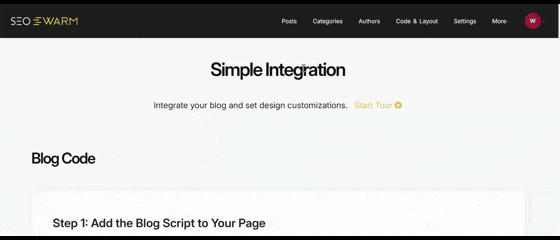
Why the Best Semantic SEO Consultants Matter
The real edge in SEO today isn’t about chasing keywords—it’s about building meaning and trust at scale. The best semantic SEO consultants don’t just optimise for algorithms; they architect your content to answer real questions, connect entities, and future-proof your site against whatever Google throws next.
If you’re serious about organic growth, I recommend you take these next steps: - Review each consultant’s track record and demand proof—case studies, dashboards, and schema validation. - Score candidates on technical depth, reporting clarity, and their ability to integrate with your team and platform. - Prioritise those who can build topic clusters, implement schema, and communicate results in a way your business can act on.
I’ll leave you with this: In a world where context outranks keywords, the right consultant turns your website into an authority—one entity, one topic cluster, and one structured page at a time.
— Wil
